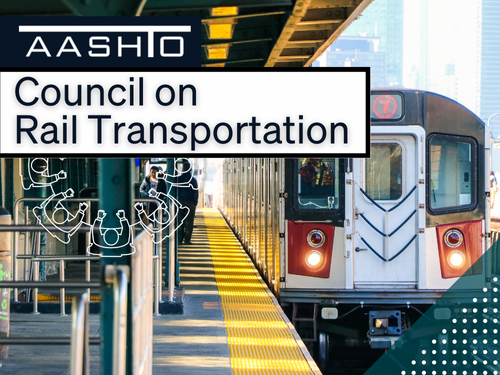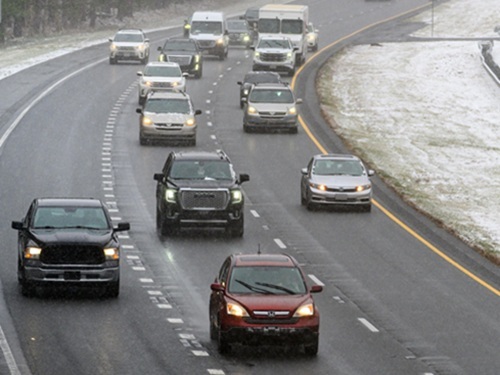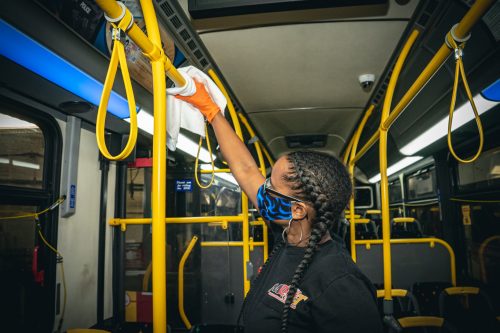The American Public Transportation Association launched a national “Health and Safety Commitments Program” for transit agencies during a virtual event on September 9. The safety program is designed to assure passengers that public transit systems are “taking all the necessary measures to operate safely” as the nation recovers from the COVID-19 pandemic.
[Above photo by the Maryland Transit Administration.]
“The program being launched today is the public transportation industry’s pledge to promote sensible policies and practices designed to keep transit users and transit employees safe during the COVID-19 crisis,” explained Paul Skoutelas, APTA’s president and CEO, during the virtual event.

“It is a logical extension of the innovation and commitment we have been demonstrating for the past several months – and it makes the need for at least $32 billion in additional [federal] emergency funding that much more urgent and critical.”
“This program emphasizes the commitment that this industry is making to all those we serve now and to those who we look forward to serving,” added Nuria Fernandez, APTA chair and general manager/CEO of Santa Clara Valley Transportation Authority.
“Public transportation is and will be vital to the social and economic recovery of our nation,” she stressed. “But getting there requires us to win back our ridership and encourage new riders to view public transit as a preferred mobility choice. We believe this commitment program will help do this.”

Phil Washington, APTA’s mobility recovery and restoration task force chair and CEO of the Los Angeles County Metropolitan Transportation Authority, noted during the event that APTA developed this program based on three consecutive days of focus groups in 15 different markets with 2,000 public transportation users.
“Those focus groups covered all modes of transit – urban, suburban, and rural areas – and included everyday passengers and those who use transit on a less frequent basis,” he said. “Riders told us they felt safety was a joint responsibility of transit agencies and passengers and offered specific things that would make them feel safer and more confident to keep using public transit systems.”
From that research, APTA identified four key areas that transit systems need to address to earn riders’ confidence:
- Following public health guidelines from official sources
- Cleaning and disinfecting transit vehicles frequently and requiring face coverings and other protections
- Keeping passengers informed and empowered to choose the safest times and routes to ride
- Putting health first by requiring riders and employees to avoid public transit if they have been exposed to COVID-19 or feel ill.
“Winning riders back is a process, not a one-time action,” Washington added.
“This program will help us do that by showing we’re doing our part. But we are also under enormous pressure every day to maintain clean, safe operations – and we cannot do that effectively without more emergency funding,” he explained.

“We desperately need more federal emergency funding to prevent the devastation of our national transit systems that are vital to social and economic recovery of our nation as well as win back ridership,” Washington added.
APTA’s Skoutelas emphasized that while the public transportation industry was “very appreciative” of the $25 billion in transit aid provided by the $2 trillion CARES Act in March, “it became very clear in matter of few weeks that it would not be enough. The depth of the pandemic and the economic downturn required more [funding] support to provide a bridge between now and a full economic recovery.”
He pointed out that the $32 billion requested by the public transit sector from Congress “is based on research of needs. Therefore, we continue to press the case that [transit] agencies need this additional resource to maintain their operations. Hopefully we will get a positive response before Congress adjourns this fall.”

Some state departments of transportation are initiating similar programs on a smaller scale.
For example, the Alaska Department of Transportation & Public Facilities in partnership with the Alaska Department of Health & Social Services and the state’s travel industry recently launched the “Safe Travels” program to promote personal health-safety and increases awareness about Alaska’s COVID-19 health mandates and advisories.
“There are relatively few routes of entry into Alaska, making our state essentially an island,” explained John MacKinnon, Alaska DOT&PF commissioner, in a statement. “[This] is a strategic effort to reach travelers before they arrive and provide them the information they need to make their travel decisions.”
 Nation
Nation
Registration Open for AASHTO’s Winter Rail Meeting
December 19, 2025 Nation
Nation

